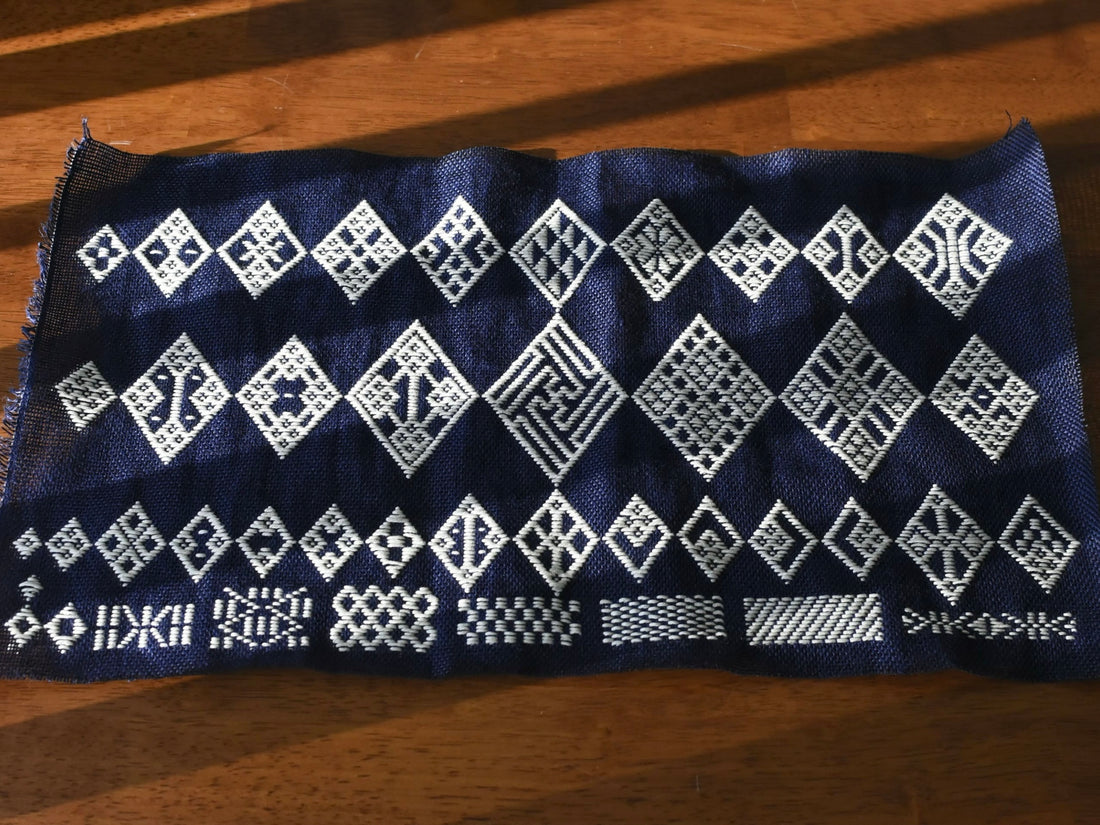
What is the Koginzashi pattern?
◆What are Kogin embroidery patterns?
At the Japan Fair the other day, someone showed me a Kogin piece they had embroidered themselves. They prefaced it by saying, "Of course, I'm sure you know this pattern," but I didn't know what it was. It was a creative design that didn't fit the rules of traditional patterns. They told me they'd made it after looking at a book on Kogin embroidery , but it was the first time I'd ever had such a genuine question arise in my mind: What is Kogin embroidery? If there hadn't been a preface, I wouldn't have thought it was a Kogin embroidery design.
◆Does it matter whether the pattern is traditional or not?
In the end, I learned that whether a pattern is traditional or not does not necessarily indicate Kogin embroidery. I learned that a pattern in a book labeled "Kogin embroidery" is "Kogin embroidery" . I can imagine that it is a modern pattern for Japanese people, but that is unlikely to happen overseas. At the same time, in America, where the range of information about Kogin embroidery is limited, I imagined a person telling their family and friends that their work is Kogin embroidery and it spreading, and I thought that cultures can easily differentiate. They are both Kogin embroidery if you trace them back to their origins, but they are different things if you don't trace them back to their origins.
At the nearby supermarket, California rolls and nigiri sushi are displayed side by side. At Kura Sushi, you can eat both nigiri sushi and California rolls. I thought that having both might be important. Enjoying a non-traditional pattern while knowing the existence of traditional patterns and enjoying a non-traditional pattern as Koginzashi without knowing the existence of traditional patterns are similar but completely different, I thought. The presence of B highlights the presence and outline of A, and it may be the non-traditional pattern that highlights the outline of the traditional pattern. I feel that the non-traditional pattern made me want to think about traditional patterns. It was a wonderful experience.

(Basic patterns of Kogin embroidery and patterns used in old Kogin embroidery)
◆I will continue to enjoy traditional Kogin embroideryI continue to practice Kogin embroidery in the United States. In May 2024, I taught Kogin embroidery at an event introducing the cultures of various countries at my son's elementary school, and at the end of June at an event called Japan Fair. I explained how Kogin embroidery was born, its historical background, regulations, and the meaning of the patterns. I was even given time on stage to introduce the art created by farmers, and I was able to teach the many visitors.
At the Japan Fair, next to the colorful accessories and other items for sale, we placed imitation Azuma Kogin items with white thread on a navy blue background, a list of patterns, and a board with an explanation of Kogin embroidery. Many people stopped in front of the Azuma Kogin explanation board. They understood Kogin embroidery and increased the value of the items with their knowledge before picking up the items for sale. More people asked questions enthusiastically than at any previous event, and conveyed their respect for traditional Kogin embroidery through their expressions and words. And there was a charm to Kogin embroidery that could only be seen because it was not in Japan.
Nowadays, there are many different kinds of Kogin embroidery, but I still want to learn more about the flexibility of traditional patterns, so I would like to continue enjoying it. I would like to share its charm while having fun. I learned a lot from the respect shown to me by everyone I met in America.

Kogin stitching for now (Kogin surrendering to the freedom of traditional patterns)
◆If you enjoy it in your own wayToday, I wrote down my thoughts after the event the other day. It was a valuable experience, so I'm leaving it here, but of course there are people who think the same and people who don't. I think there is a charm to Kogin embroidery that only those who enjoy modern patterns can know. Above all, I think that those who are interested in Kogin embroidery can further enhance the charm of Kogin embroidery by thinking about it, so I hope that everyone will continue to have a fun time. It's been two months since the event, but I would like to leave a blog about the event soon! I hope you will continue to support me.
We are also preparing for an event where we will create larger Kogin pieces using traditional patterns!
▶️Materials Research Blog
▶️Shop (We plan to expand the digital design lineup in the future, except when we are temporarily back in Japan)
▶️Instagram (We share the simplicity and fun of Kogin embroidery through videos, etc.)
▶︎Goldfish Nebuta Kit Design and Instruction Data for Sale
(We have added a design sample to the work examples)
・Goldfish Nebuta with a gentle face▶️ minne sales page
・Goldfish Nebuta with a brave face▶️ minne sales page
Satonobou
